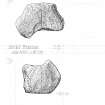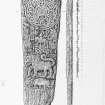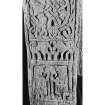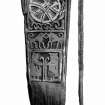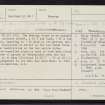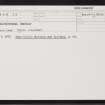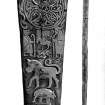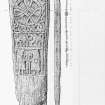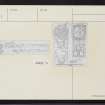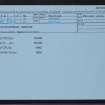Pricing Change
New pricing for orders of material from this site will come into place shortly. Charges for supply of digital images, digitisation on demand, prints and licensing will be altered.
Bressay, Cullingsburgh
Cross Slab (Early Medieval), Ogham Inscribed Stone (Early Medieval)
Site Name Bressay, Cullingsburgh
Classification Cross Slab (Early Medieval), Ogham Inscribed Stone (Early Medieval)
Alternative Name(s) Bressay Stone; Cubinsgarth, St Mary's Church
Canmore ID 1279
Site Number HU54SW 12
NGR HU 521 423
NGR Description HU c. 521 423
Datum OSGB36 - NGR
Permalink http://canmore.org.uk/site/1279
- Council Shetland Islands
- Parish Bressay
- Former Region Shetland Islands Area
- Former District Shetland
- Former County Shetland
Bressay, Culbinsburgh, Shetland (St Mary), cross-slab
Measurements: H 1.22m, W 0.27m – 0.40m, D 0.06m
Stone type: chlorite schist
Place of discovery: c HU 521 423
Present location: National Museums Scotland, Edinburgh (IB 109)
Evidence for discovery: found in the first half of the 19th century below ground-level near St Mary’s Church but outside the graveyard. It was taken first to Gardie House in Bressay, and thence to a churchyard about a mile to the south of Gardie House. In 1852 it was sent to Newcastle for exhibition, returned to Bressay and in 1864 presented to NMAS (ECMS pt 3: 5-6).
Present condition: some wear.
Description
The cross-slab is carved in low relief on both main faces, and there is an ogham inscription along both narrow faces. Face A bears a cross within a circular frame; the arms of the cross have wide expanded terminals, and they, the centre of the cross and the spaces between the arms are filled with simple interlace. Above the cross two animal heads grasp a prone human body in their jaws. Below the cross two hooded clerics with crosiers and book satchels flank a figure riding a horse, and beside the face of the left-hand cleric is a simple incised cross which has been interpreted as representing a cross-slab (Kilpatrick 2011: 166). Below the clerics is a large animal, probably a lion, and below that a smaller animal, perhaps a pig.
Face C is carved with an interlaced cross-of-arcs within a circle surrounded by interlace and framed by another pair of beasts biting a human figure. Beneath the cross panel is one containing two confronted beasts, and beneath them a panel containing two hooded clerics with crosiers and book satchels.
Faces B and D are incised with a long inscription in ogham, which reads ‘the cross of Nadd Oddr’s daughter aNN [in memory of her husband] Benises son of Droan’. There is a degree of linguistic mixture, because the word for daughter is Norse, while those for cross and son are Gaelic. It has been suggested that the horseman on face A may represent Benises for whom the monument was set up (Scott & Ritchie 2009: 7).
Date: tenth century.
References: ECMS pt 3, 5-10; DES 1997: 67; Trench-Jellicoe 2005: Scott & Ritchie 2009, no 54; Kilpatrick 2011, 164-7.
Compiled by A Ritchie 2016
HU54SW 12 c. 521 423.
(Area centred HU 521 423) The Bressay Stone is an upright cross-slab of chlorite schist, 3ft 9ins high, 1ft 4ins wide at the top, tapering to 1ft wide at the bottom, and 1 3/4ins thick, sculptured in relief on the two broad faces and with ogham inscriptions on the two narrow sides. This much-travelled stone is said to have been found in a waste piece of ground at Cubinsgarth near the old ruined church of St Mary (Shetland 53SE 5 - HU54SW 5).
It was presented to the National Museum of Antiquities of Scotland (NMAS) in 1864 by the Rev Z M Hamilton, D D.
E Charlton 1854; Archaeol J 1855; Stuart 1856; J R Allen 1903; RCAHMS 1946.
No further information.
Visited by OS (NKB) 16 May 1968.
This stone remains in the NMAS.
{Undated] information in NMRS.
Note (1946)
Sculptured Stone from Cullingsburgh. This stone (Figs. 476 and 477), popularly known as the Bressay Stone and believed to have been originally found near the ruins of St. Mary's Church at Cullingsburgh (HU54SW 5), is now preserved in the National Museum of Antiquities. It is of chlorite schist and measures 3 ft 9 in in height, being 1 ft 4 in wide at the top, 1 ft wide at the bottom, and 11 in thick. It is sculptured in relief on the two broad faces and inscribed on the narrow edges:
[Description from Allen and Andersson 1903, ECM, iii, 6-8].
"Front (Fig. 476). Near the top of the stone is a cross with arms having expanded ends, within a circle. The whole of the cross and the spaces between the arms are covered with interlaced work.... At each of the upper corners of the slab, above the circular cross, is a monster disgorging or swallowing a small human figure placed between the two.... On each side of the circular cross are traces of interlaced ornament.
Immediately under the circular cross, in the centre, is a man on horseback, and on each side an ecclesiastic with pointed hood, crosier, and book-satchel slung over the shoulder. Above the horseman to the right is an S-shaped object like a serpent, and on the left a small equal-armed cross incised.
Below the figures just described is a piece of plait-work composed of four bands, and two beasts, one below the other. The upper one has the tail curled over its back and the lower one resembles a fat pig.
Back (Fig. 477).-Divided into three panels containing (1) a circular cross composed of inter laced rings, surrounded, along the top and sides, by two twisted bands forming loops in each 3 corner; and along the bottom side by two twisted bands combined with circular rings; (2) a pair of beasts with curling tails and open mouths facing each other; and (3) two ecclesiastics standing opposite to each other with pointed hoods, crosiers, and book-satchels.
Right Side. An ogham inscription on a stem line along the centre of the face in four words divided by double points, reading from the bottom upwards.
Left Side. A similar inscription to that on the right side in three words, also reading from the bottom upwards.
The Bressay Stone is described and illustrated in Stuart's Sculptured Stones (vol i, plates 94 and 95 and p. 30); D. Wilson's Prehistoric Annals of Scotland (2nd ed. vol. ii, p. 240); the Journal of the British Archaeological Institute (vol. xxviii, p. 181).
Readings of the inscription will be found in R. Brash's Ogam Inscribed Monuments (p. 355); Sir J. Ferguson's Ogham Inscriptions (p. 135) ; by Dr. Graves in the Proceedings of the Royal Irish Academy (vol. vi, p. 248); by the Rt. Hon. the Earl of Southesk in the Proc. Soc. Ant. Scot. (vol. xviii, pp. 186-98); and by Professor John Rhys, LL.D., in the Proc. Soc. Ant. Scot. (vol. xxvi, p. 297).
The way in which the inscription is cut on a stem line, with vowels represented by cross strokes instead of notches on the angle of the stone, with points between each word, and other peculiarities, shows that it belongs to the later or scholastic variety of ogham writing found in the Book of Ballymote and other Irish MSS., ranging in date from the ninth to the seventeenth centuries."
Rhys (1892, 297), in the paper referred to above, reads the two lines of oghams together as meaning ‘The cross of Natdad's daughter, child of Maqqddrroann’, which cannot be regarded as certain. It is possible that the oghams were cut on the stone at some time subsequent to its first erection.
RCAHMS 1946 No. 1084, pp.2-3, figs. 462, 476-7
















